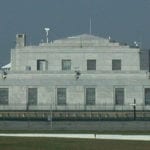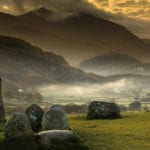 Technology
Technology  Technology
Technology  Humans
Humans 10 Everyday Human Behaviors That Are Actually Survival Instincts
 Animals
Animals 10 Animals That Humiliated and Harmed Historical Leaders
 History
History 10 Most Influential Protests in Modern History
 Creepy
Creepy 10 More Representations of Death from Myth, Legend, and Folktale
 Technology
Technology 10 Scientific Breakthroughs of 2025 That’ll Change Everything
 Our World
Our World 10 Ways Icelandic Culture Makes Other Countries Look Boring
 Misconceptions
Misconceptions 10 Common Misconceptions About the Victorian Era
 Mysteries
Mysteries 10 Strange Unexplained Mysteries of 2025
 Miscellaneous
Miscellaneous 10 of History’s Most Bell-Ringing Finishing Moves
 Technology
Technology Top 10 Everyday Tech Buzzwords That Hide a Darker Past
 Humans
Humans 10 Everyday Human Behaviors That Are Actually Survival Instincts
 Animals
Animals 10 Animals That Humiliated and Harmed Historical Leaders
Who's Behind Listverse?

Jamie Frater
Head Editor
Jamie founded Listverse due to an insatiable desire to share fascinating, obscure, and bizarre facts. He has been a guest speaker on numerous national radio and television stations and is a five time published author.
More About Us History
History 10 Most Influential Protests in Modern History
 Creepy
Creepy 10 More Representations of Death from Myth, Legend, and Folktale
 Technology
Technology 10 Scientific Breakthroughs of 2025 That’ll Change Everything
 Our World
Our World 10 Ways Icelandic Culture Makes Other Countries Look Boring
 Misconceptions
Misconceptions 10 Common Misconceptions About the Victorian Era
 Mysteries
Mysteries 10 Strange Unexplained Mysteries of 2025
 Miscellaneous
Miscellaneous 10 of History’s Most Bell-Ringing Finishing Moves
Top 10 UK Locations from Literary Works That You Can Actually Visit
Have you ever read a book that described a location so vividly that you wished you could visit it? Well, sometimes you can. Often authors are inspired by real-world places when crafting their book settings, whether based in our world or a fantasy one. This means that readers who have been bitten by the travel bug can set off on real adventures to explore some of their favorite locations from literature.
This list rounds up 10 UK locations from classic books that you can actually visit, providing a literary tour of England, Scotland, Wales, and Northern Ireland. They are listed from “loosely related” to “basically identical.” So even if you aren’t a bookworm, this list likely includes a true classic or a more modern work that you love with an accompanying destination worth exploring.
Related: 10 Rude-Sounding British Places With Unbelievable Backstories
10 Glamis Castle and Cawdor Castle: Macbeth (1606) by William Shakespeare
Although Macbeth is based on the life of a real Scottish king, Shakespeare was no historian, and his version is highly fictionalized. Macbeth is described as the Thane of Glamis and the Thane of Cawdor, but these castles weren’t actually built until around 300 years after Macbeth’s death. Both castles have fostered this literary connection, though.
Glamis, which looks like an ornate French chateau, has a walking trail that features wooden carvings of the main characters from Shakespeare’s play and a grand hall named after one of Macbeth’s victims, King Duncan. Of course, it has its own history of murder and witchcraft, too (as do the majority of Scottish castles).
Cawdor is a medieval fortress built around a holly tree (now petrified at the base of the old tower) due to a vision apparently experienced by the Thane of Cawdor (the real one, not Shakespeare’s Macbeth). He was instructed in a dream to let a donkey roam and then build a castle wherever it lay down to sleep. Like Glamis, Cawdor takes advantage of the Shakespeare connection and has previously staged a production of Macbeth.[1]
9 Llandudno: Alice’s Adventures in Wonderland (1865) by Lewis Carroll
Alice Pleasance Liddell (now known as the real “Alice” in Wonderland) spent summer holidays with her family in the Welsh seaside town of Llandudno. The Liddells were close friends with Charles Dodgson, better known by his pen-name, Lewis Carroll, and the story goes that he was inspired by Alice’s adventures in Llandudno.
The Welsh town has made the most of this association, beginning with a White Rabbit statue installed in 1933 and continuing with a number of Wonderland Town Trails. These trails cover much of the Victorian resort town, which has the longest pier in Wales, and feature statues of characters from Carroll’s fantastical novel. You can now even explore the trails with augmented reality.[2]
8 Unst: Treasure Island (1883) by Robert Louis Stevenson
While there is no record of exactly which island inspired Treasure Island, Robert Louis Stevenson certainly had a few to pick from. His father was a lighthouse engineer, and Stevenson would often accompany him on visits to various islands. There are around 900 islands surrounding mainland Scotland, but Unst has a particularly strong claim.
Stevenson traveled to Unst, part of the Shetland Islands and the UK’s most northerly inhabited island, with his father in 1869. Beautiful and relatively isolated, it is easy to see why this island would spark a story about pirates. Paula Williams, the curator of the Maps, Mountaineering, and Polar Collections at the National Library of Scotland, explains that the outlines of both islands resemble each other “complete with corresponding inlets and [the] small islet Skeleton Island, [as it is called in the novel], or Uya [its real name].”[3]
7 Edinburgh: The Harry Potter Series (1997–2007) by J. K. Rowling
J. K. Rowling created the Wizarding World while living in Edinburgh, and the city’s grand architecture and cobbled alleyways are reflected in the books. Candlemaker Row features a plaque and mural to mark it as the inspiration of Diagon Alley. But if you type “Diagon Alley” into Google Maps, it will send you to Victoria Street, which feels just as wizardly with its colorful shops and secret stairways.
Another link between the Scottish capital and Harry Potter can be found in Greyfriars Kirkyard, a 17th-century cemetery. The cemetery features the gravestone of Thomas Riddell, which only slightly differs in spelling from the birth name of Lord Voldemort, Tom Riddle.
You can also visit places where parts of Harry Potter were written. The earlier books were largely written in The Elephant House café, and the series was finished in a room (now named The J. K. Rowling Suite) at the Balmoral Hotel. The suite features subtle Harry Potter decorations, but it isn’t cheap, costing almost £2000, or $2700, for a one-night stay.[4]
6 Haworth: Various Novels by the Brontë Sisters
This entry covers books written by the Brontë sisters, primarily Charlotte’s Jane Eyre (1847), Emily’s Wuthering Heights (1847), and Anne’s The Tenant of Wildfell Hall (1848). The sisters lived in the Yorkshire village of Haworth, which is surrounded by dramatic moorland, and they set their novels in the area, which is now known as Brontë Country.
Their family home has been turned into the Brontë Parsonage Museum, which houses the largest collection of Brontë manuscripts, letters, and early editions of poetry and novels. Around the area are various properties which inspired buildings from the novels. Top Withens, a ruined farmhouse located on the moors near Haworth, inspired Wuthering Heights, while Gawthorpe Hall and Wycoller Hall served as Ferndean Manor in Jane Eyre. There is even a 44-mile trail called the Brontë Way, which links key locations from the books.[5]
5 Antrim Coast and County Down: The Chronicles of Narnia (1950–1956) by C. S. Lewis
In fiction, the world of Narnia is accessible through a wardrobe; in reality, it is located in Northern Ireland. C. S. Lewis’s fantasy world was inspired by the landscapes of the Antrim Coast and County Down. In a letter to his brother, he declared, “That part of Rostrevor which overlooks Carlingford Lough is my idea of Narnia.” And in his essay “On Stories,” he stated, “I have seen landscapes (notably in the Mourne Mountains) which, under a particular light, made me feel that at any moment a giant might raise his head over the next ridge.”
It is easy to see how the rugged vistas of Northern Ireland inspired Lewis. The ruins of Dunluce Castle, perched on a cliff above the sea, would fit comfortably within the world of Narnia. The hexagonal basalt columns of the Giant’s Causeway feel infused with the magic which Lewis saw in the country. Legend has it that the giant Finn McCool built the Causeway as a bridge over to Scotland. Although New Zealand was the filming location for the movies, the closest you can get to Lewis’s idea of Narnia is Northern Ireland. [6]
4 Oxford: His Dark Materials (1995–2000) by Philip Pullman
There are many magical locations visited in Philip Pullman’s His Dark Materials, but the story starts in an alternate version of Oxford. Pullman attended the University of Oxford during the ‘60s, and it clearly left an impact on him because his main character, Lyra, grows up at the university. All of the college buildings spread throughout the city look impressive, but the basis for the fictional Jordan College was probably Pullman’s alma mater, Exeter College. When filming the TV series, though, New College was used as a substitute for Jordan.
There are many Oxford landmarks mentioned throughout the books. You can visit the Covered Market, which sells far more than just the fish mentioned in The Golden Compass; The Pitt Rivers Museum, which Lyra explores in The Subtle Knife; and Jericho, a neighborhood with canals where Pullman’s Gyptians moor their narrowboats.[7]
3 Birmingham: The Lord of the Rings (1937–1949) by J. R. R. Tolkien
J. R. R. Tolkien, like his friend C. S. Lewis, was inspired by where he grew up when creating the fantasy world for his novels. Though, again like C. S. Lewis, the adaptations of his works were filmed in New Zealand. Tolkien grew up in and around Birmingham, and the area inspired his descriptions of Middle Earth.
The Shire, the idyllic home of the hobbits, was based on Sarehole, Tolkien’s childhood home, which he described as a “kind of lost paradise.” The peaceful English village was composed of old-fashioned cottages (now gone) and an old mill (which is now a museum). Close by is Moseley Bog, a densely wooded area that is reminiscent of the Old Forest on the edge of the Shire.
Landmarks in the city of Birmingham also inspired the author. For instance, Perrott’s Folly and Edgbaston Waterworks Tower helped Tolkien conjure up his Two Towers. The industrialized Black Country of Birmingham was expanding into his beloved countryside and can clearly be seen as a version of the hellish Mordor.[8]
2 Whitby: Dracula (1897) by Bram Stoker
Bram Stoker drew extensively on Transylvanian folklore when he was researching Dracula. Still, while the novel starts at Dracula’s castle in Transylvania, key elements of the Gothic story did not come together until he visited Whitby for a vacation in 1890. He then chose the English seaside town as one of the novel’s central locations.
Dracula, in the form of a wolf-like creature, runs up the 199 steps that wind up to the impressive ruins of Whitby Abbey. St. Mary’s Churchyard was featured as the location where Lucy is first attacked by the vampire. Whitby’s atmospheric scenery was not the only thing that inspired Stoker, though. He heard of a Russian ship, the Dmitry, which was wrecked on Tate Hill Sands in 1885, and this made it into his novel in the form of Dracula’s ship, the Demeter, meeting the same fate.
In the public library, he read a book that mentioned Vlad Tepes, known as Vlad the Impaler or Dracula. He added the note “Dracula in the Wallachian language means Devil,” and thus, he found the name of his Count. Before this, Stoker had planned to call his vampire Count Wampyr, a name so bad that it probably would have doomed the novel to obscurity.[9]
1 Ashdown Forest: Winnie-the-Pooh series (1925–1928) by A. A. Milne
If A. A. Milne’s childhood classic books featuring Winnie-the-Pooh and friends adventuring in Hundred Acre Wood captured your imagination as a child, then I’ve got good news for you! Hundred Acre Wood is real, and it’s called Ashdown Forest. Christopher Milne, son of A. A. Milne and inspiration for Christopher Robin, wrote in his autobiography that “Pooh’s forest and Ashdown Forest are identical.”
In 1925 the Milne family bought a holiday home near Ashdown, located only 30 miles from London, in East Sussex. Their time among the pine trees and heathland inspired the classic children’s books. You can even visit the footbridge where Christopher and Pooh play Poohsticks. In the nearby village of Hartfield, you can find Pooh Corner, the village sweet shop that the family visited, which is now a Pooh-themed tea room and museum (called the Pooh-seum).[10]








